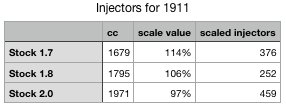
I was looking at these injectors at FiveOMotorsports. The FiveO injectors don't explicitly state their testing pressure, but industry standard is 3-bar. So using the chart above you can find the best fit injectors for stock replacement. BUT YOU MUST CONSIDER WHAT FUEL PRESSURE YOU WANT TO RUN. Considering a stock 2.0, you either need 475cc@3bar injectors at 28psi, OR 380cc@3bar injectors at 43psi. And higher fuel pressure improves atomization, so I'd upgrade to 3bar fuel pressure.
and now to get to the actual question, "What injectors to use with a 1911?" you also have to consider the collection of components your using. I'm going to answer this based on the assumption that you're using a complete and correct setup, meaning matching ECU, MPS, etc.
(also note: cam choice can make a difference here too because different cams will have different VE results)
Okay, so here we go:

So a 1911 is 14% bigger than a stock 1.7. So assuming you had a perfect, complete 1.7 fuel injection system (which implies 'perfect' tuning) that you were installing on a 1911, you would use 380cc@3bar injectors, run at 28psi to compensate for the increase in displacement.
The 1.8 injection would work best with 250cc@3bar running at 28psi and 2.0 injection would work bets with 450cc@3bar injectors run at 28psi.
My thinking, as I type this, is that the tuning of the stock fuel injection is tied to the ECU, MPS and Injectors (mostly). So which collection of components you're using would change which 'upgraded' injectors you would need for a 1911.
Okay, I'm even confusing myself with some of this info. Ask questions...
